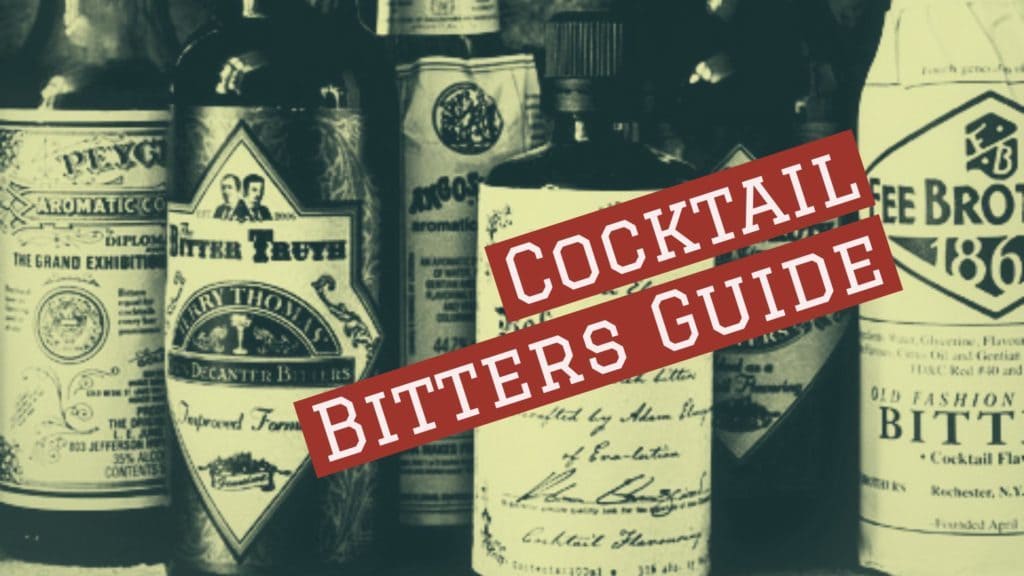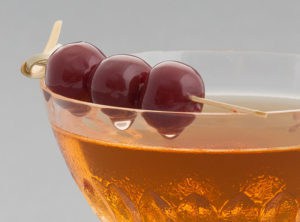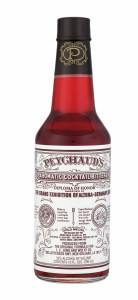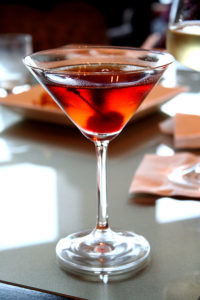Cocktail Bitters

Cocktail bitters play a huge part in the in the current cocktail renaissance. The rediscovery of classic cocktails and advanced in the craft cocktail movement have transformed the way people drink.
Aromatic cocktail bitters are a huge part of many of the drinks being created by the world’s best bartenders. It is hard to understate how much demand has grown for one of the less understood ingredients in the bartender’s toolbox. In this guide to using cocktail bitters, we hope to provide you a framework for thinking about how to use them in your own drinks.
Who is this guide for?
This guide is for professional and at-home bartenders and anyone else who is looking to level up their cocktail game. If making great cocktails is important to you, or your customers, then you should read this guide. If you are interested in learning to develop your own cocktail recipes then you should read this guide.
How to Use This Guide
Each section stands on its own. Feel free to skip around and read what you find interesting in isolation. To get the most out of the guide it makes sense to read it all the way through and then return to it as a resource when needed.
In this guide
- What Are Bitters?
- Using Bitters in Cocktails
- Defining Bitters as a Flavor
- Tasting Bitters
- Types of Bitters
- Drinks Made With Bitters
- Where Can You Buy Bitters
- Making Your Own Bitters
What Are Bitters?
What, exactly, are cocktail bitters? Bitters are an aromatic flavoring compound made by infusing a high proof alcohol with roots, spices, herbs and other botanicals.
Popular styles of bitters include aromatic bitters like Angostura or Peychaud’s. Citrus bitters like orange bitters or grapefruit bitters have been gaining popularity in recent years. But the craft cocktail revolution has also introduced a whole world of flavors to explore. You can now find all lavender bitters, black walnut bitters, cardamom bitters, the list goes on…
Cocktail bitters were originally sold as medicine. They cured whatever ailed you, or at least they claimed to. People have been using herbs, roots, and botanicals for healing for thousands of years. Patent bitters were just another variation in a long line of elixirs, tonics, potions and tinctures to aid in healing, digestion, and most importantly cure a hangover.

Bitters for Cocktails – Some Background
Bitters first found their way into cocktails as early as the 1700’s. They would be added to brandy with a little sugar as a morning pick me up.Once people started putting bitters in cocktails it was a short leap from patent medicine to flavoring agent.
The cocktail grew out of the medicinal use of bitters. Cocktail bitters are an intensely concentrated flavor in a high proof alcohol base. Taking your ‘medicine’ wasn’t necessarily a pleasant experience. People started adding bitters and sugar to their brandy with a little water to make it go down easier. In time, this became known as a cocktail.
Eventually, people had been doing this for so long that it started to be referred to as taking your cocktail the ‘Old Fashioned’ way. When you dash some bitters in your Old Fashioned you are participating in a ritual that has been practiced for over two hundred years now.
The Near Demise of Cocktail Bitters
Bitters nearly vanished with modern medicine. Regulations came along that said medicines should actually cure disease. Most bitters producers went out of business. Prohibition dealt another blow to medicinal bitters. Today there are a handful of bitters producers that have survived including Angostura, Peychaud’s and Fee Brothers.
It is the use of bitters as a flavoring agent that is the reason that bitters are still used today. With the advent of modern medicine regulations that required medicines to be effective most bitters producers were nearly driven to extinction. The ones that survived did so because they were integral to cocktails.
Bitters take their name from a group of botanicals known as bittering agents that make up their base flavor notes. Bittering agents are often roots or barks and include gentian, cinchona bark, and licorice root among many others.
How to Use Bitters in a Cocktail?
Bitters are frequently described as the bartender’s salt and pepper. It is a pretty apt description. They are the seasonings of the cocktail world. They can be used as a flavor enhancer, a finishing top note, or an interesting aromatic on the nose of a cocktail.
Bitters are mixed into drinks to add spice, depth, and complexity. They help to marry flavors and round out the rough edges. You will find them everywhere in classic cocktails like the Old Fashioned, Manhattan or Martinez.

Defining Bitter as a Flavor
Bitter is one of the distinctive flavor categories that scientists have determined humans can taste. The others include sweet, sour, salty, umami (savory) and most recently fatty. In cocktails, we want to play these flavors off of each other to make our drinks more interesting and flavorful. This is what is commonly referred to as balance.
The Bitter/Sweet Balance
In cocktails, as in cooking, balance is often understood as sweet and sour, or bitter and sweet. There are many other aspects to balance and many people strive to balance as many of the five flavors as they can. In fact, this is one of the hallmarks of many Asian cuisines. In the cocktail realm, we are most interested in the bittersweet balance because it is fundamental to the structure many classic cocktails.
Bitterness as an Evolved Taste
To start to understand bitterness as a flavor it helps to know why we taste it.The reason we taste different flavors, from an evolutionary standpoint, is that they helped direct early humans to foods that helped them survive. They also helped us to avoid dangerous or poisonous foods. Sugars, fats, salts and proteins are all beneficial to supporting life. They also taste delicious and so we seek them out.
Bitter flavors are a little different. It is generally thought that humans have developed taste receptors for bitterness as a way to avoid eating toxic or poisonous plants and animals. Obviously, this serves us well from an evolutionary standpoint, but why would we then seek out bitter flavors in our many of our favorite foods. Chocolate, coffee, hops in beer, alcohol, many herbs and greens, teas and wines all contain bitter flavor compounds. So what purpose does our enjoyment of bitter flavors serve from an evolutionary standpoint?
Bitters as a Digestive Aid
One of the really interesting things about bitter flavors is that bitter are not only sensed in the mouth, but also in other tissues outside of the mouth. One of the areas these bitter taste receptors are found is throughout the gastrointestinal tract. This may be an indication that bitter flavor compounds may actually aid in digestion.
The science on this may not be conclusive yet, but the folk wisdom is well established. People have been eating and drinking bitter foods and drinks as an aid to digestion for thousands of years. In fact, the Italian love of Apertivo has elevated the use of bitter liqueurs to an elaborate daily ritual designed to open the digestive tract in preparation for dinner.
Cocktail Bitters as a Flavoring Agent
Bitter flavors on their own have a sharp, puckering taste that seems to register near the middle back of the tongue. They are most accompanied by astringency, an effect that leads to a dry mouthfeel. While bitterness is a flavor, astringency is more of a component of mouthfeel. Together they provide a great deal of depth and complexity of flavor.
Bitters as a Palate Cleanser
Cocktail bitters are fantastic for the palate-clearing effect that they have. In aromatic cocktail bitters, the bittering agents are often roots or barks which very often contain astringent compounds. Sugars and fats coat the tongue and have a lingering effect. Bitterness, on the other hand, is perceived as a dryness on the tongue. This drying effect cuts through fats and sugars and clears the palate. So, while fats and sugars help satisfy the appetite, bitterness actually prepares the tongue to take another bite.
This is one of the reasons that highly tannic wines pair so well with heavily marbled steaks. The bitter tannins in a big bold merlot or cabernet cut through the delicious buttery fat of a great ribeye and make the whole meal more satisfying. To get a sense of how this works try tasting a big red wine on its own and then spread some butter on a cracker and taste the wine again after you’ve coated your tongue with butter fat. The difference is astounding.
Cocktail Bitters as an Aromatic Compound
Aromatic bitters is another common name for cocktail bitters. It is the aromatic compounds in bitters that add interest to cocktails.
Depth and complexity of flavor can be added to a drink by mixing in bitters. This method can also help to subtly shape the mouth-feel of a drink. One of the other uses of bitters is to take advantage of their aromatic aspect.
If you watch a bartender closely you’ll often see them top a cocktail with a couple of dashes of bitters. This doesn’t influence the flavor of a cocktail itself as much. What this does is to enhance the aroma and the nose of the cocktail. The aromatic punch that this method offers is a great way to shape and enhance the overall impression of the drink.
Marrying Flavors
Bitters are terrific for marrying flavors. You know how stew tastes better the day after it was made? The effect is the same. When you are creating new cocktail recipes you will often find that the flavors are all very distinct. Each one seems to lie alongside the others revealing themselves one at a time. Sometimes this is a good thing. Other times it is not as desirable. When you are developing cocktail recipes it advisable to try a new recipe both with and without bitters.
A Word of Warning
Bitters can seem to have an almost magical ability to ‘fix’ a drink that isn’t quite working. It is really easy to begin to rely on them as a bit of crutch. Generally, it is advisable to figure out the flaw in the drink and fix it rather than use the bitters themselves as a fix.
Tasting Bitters
Tasted on their own they may be bitter, or even bittersweet. Some will have spicy, smoky or citrus notes. And yes, in the name of being familiar with your ingredients you should definitely be tasting them on their own.
Bitters are bittering agents and botanicals macerated in high proof spirits. The result is intensely flavored high proof alcohol. Most people find they are only palatable in very small amounts. Keep this in mind when you are tasting your bitters.
There are three methods for tasting bitters. You should employ all three to really get a sense of the full flavor of the bitters. You can smell the bitters, taste them directly and put a couple drops in a glass of soda water.
Understanding the Aroma
Put a couple of drops in the palm of your hand and rub your hands together. When you bring your hands up to your face you will get a good sense of the aroma of the bitters.
Cocktail Bitters Diluted With Soda
To taste the bitters directly put a couple of drops on the back of your hand and lick it off. This will give you the fullest and most direct experience of the taste of the bitters. The flavor can be intense, but this method will give you the best sense of the full flavor profile.
Tasting Bitters Directly
Finally, you should taste a couple of dashes of bitters in a glass of soda water. The dilution will open up and release the volatile flavor compounds and help you get a better sense of the flavor profile. Tasting bitters in soda will give you a good sense of the way the bitters will work in a cocktail.
Styles of Bitters
Peychaud’s Bitters VS Angostura
Angostura Bitters

The yellow cap and the oversized paper label are nearly ubiquitous behind the bar. Even in the lowest of low rent dive bars keep a bottle of Angostura bitters on hand. In many of these bars, you may even find staff who will openly wonder what it’s for. I know. I’ve been to these bars and I’d recommend you just order their best whiskey on the rocks and leave it at that.
Angostura may not be the oldest brand of bitters on the shelf, but it does rank up there as one of the longest continually produced brands. It’s omnipresence certainly, makes it the must have in your cocktail spice rack.
A German Doctor, Johannes Seigert, perfected his recipe for Angostura bitters in Venezuela in1824. Sailors quickly adopted the bitters as a remedy for seasickness. To this day it is an integral part of many classic cocktails including the Manhattan, the old fashioned and the Champagne cocktail. Only five people know the recipe for Angostura bitters. In the taste, it has a lot of spice notes. It leans towards gentian, allspice, and cloves.
The Unique Taste of Angostura Bitters
The flavor profile of Angostura bitters is sharp, woodsy and spicy. They are the benchmark flavor profile for most aromatic bitters. When you taste Angostura next to classical styles of bitters like Fee Brother’s Old Fashioned Bitters or The Bitter Truth Jerry Thomas’ Own Decanter Bitters you can see that they are variations on a theme. They may all be distinct flavors, but they are a similar style. Peychaud’s bitters, on the other hand, have their own distinct style and it is one that is difficult to substitute.
Peychauds Bitters

Peychauds Bitters are the other brand of bitters that have been around since the 19th century. New Orleans pharmacist Antoine Peychaud developed his bitters recipe around 1830. In the late nineteenth century, they became an integral ingredient in the Sazerac cocktail. Today the Peychaud’s brand is part of the Buffalo Trace portfolio who also own the Sazerac whiskey brand.
Peychaud’s bitters have a gentian-base like Angostura. The label also calls them aromatic bitters, but the similarities end there. While Angostura leans on the woodier spice notes, Peychauds has a sweeter more floral, anise and fruit character. You can taste some licorice notes, citrus peel, cherry and even some hints of saffron.
Peychaud’s are an essential part of the Vieux Carre and the Sazerac, two New Orleans classic cocktails. They also show up in the now notorious Seelbach cocktail. For this reason, alone they are an essential piece of any serious cocktail bars bitters rack.
Citrus Bitters
Citrus bitters are the other main style of bitters that have found their place behind the bar. This style of bitters work really well to lift and brighten the flavors or a drink. They are a great addition to the nose of the cocktail.
Orange bitters are the most popular variety of citrus bitters. Orange bitters are another essential ingredient in many classic cocktails. While they are easy to find these days in the early 1990’s this wasn’t the case. The story is that Gary and Mardee Regan were looking to make classic cocktails and couldn’t find orange bitters so they created their own. Regan’s Orange Bitters have become a modern classic in their own right.
You can now find a wide variety of orange bitters. Angostura, Fee Brothers, The Bitter Truth, and Scrappy’s are just some of the bitters brands that produce orange bitters. While there is obviously a general flavor at work here these brands will all have some variation on flavor. Cardamom, coriander. Caraway seeds, different varieties of orange peel and other botanicals give each of these brands a unique approach to the flavor.
Grapefruit Bitters
Grapefruit bitters are a pretty common sight behind the bar these days as well. Many bitters producers will have some sort of grapefruit bitters in their lineup. Grapefruit lends itself to some interesting flavor pairings. You can find some interesting combinations like grapefruit with hops, rosemary or black pepper.
Lemon or lime bitters are less common, probably due to the prevalence of lemon and lime in other forms behind the bar. You can still find commercially produced varieties of lemon and lime bitters. Not to mention a number of different recipes for them.They seem to confuse some bartenders as to their purpose. I find they work best to bring a bright fresh citrus note to the top of a cocktail.
Other Flavors of Bitters
There has been an explosion in the variety of bitters flavor in the past few years. A combination of growing demand and economics is driving this trend. Regulations aren’t as strict on bitters production. That means the barriers to entry are much lower for getting into the business. In some cases, the different taxation and regulation translate into much higher margins for bitters producers than for distiller, vintners or brewers. This means that consumers can now treat themselves to a wide assortment of bitters flavors.
Cardamom, habanero, saffron, and lavender almost seem commonplace in the realm of exotic bitters flavors on the market. Some of my favorites include flavors like sarsaparilla, cedar, and wintergreen.
